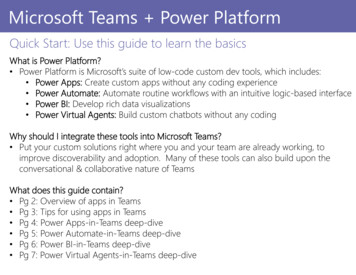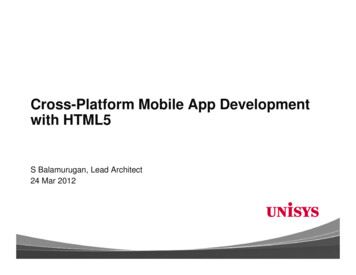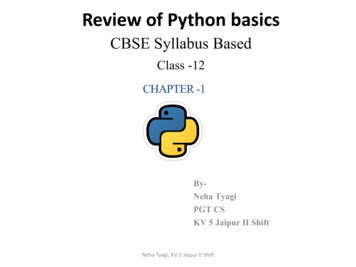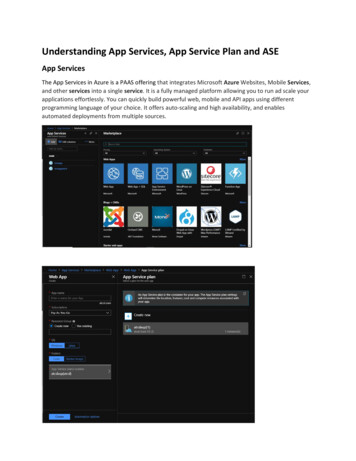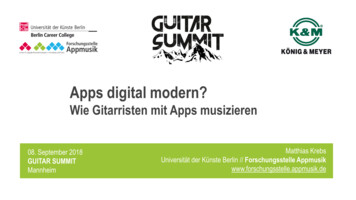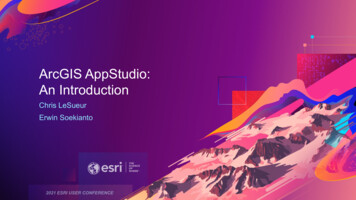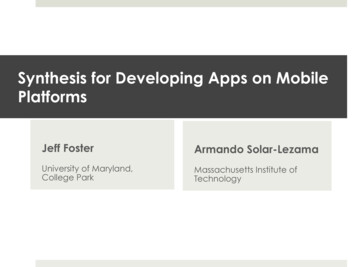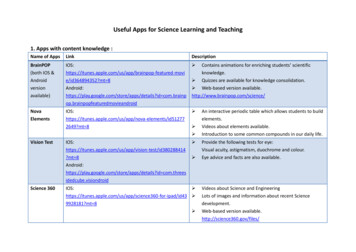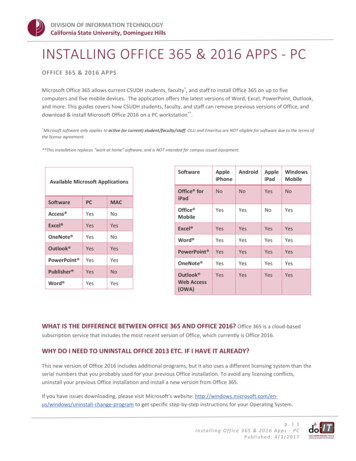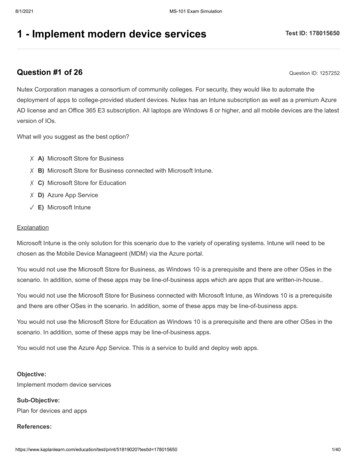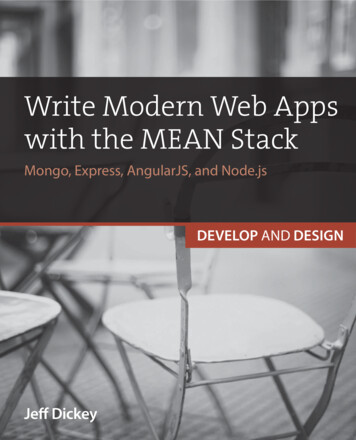
Transcription
Write Modern Web Appswith the MEAN StackMongo, Express, AngularJS, and Node.jsDEVELOP AND DESIGNJeff Dickey
Write Modern Web Appswith the MEAN StackMongo, Express, AngularJS, and Node.jsDEVELOP AND DESIGNJeff DickeyPEACHPIT PRESSWWW.PEACHPIT.COM
Write Modern Web Apps with the MEAN Stack: Mongo, Express, AngularJS, and Node.jsJeff DickeyPeachpit Presswww.peachpit.comTo report errors, please send a note to errata@peachpit.comPeachpit Press is a division of Pearson Education.Copyright 2015 by Jeff DickeyEditor: Kim WimpsettProduction editor: David Van NessProofreader: Liz WelchTechnical editor: Joe ChellmanCompositor: Danielle FosterIndexer: Danielle FosterCover design: Aren StraigerInterior design: Mimi HeftNotice of RightsAll rights reserved. No part of this book may be reproduced or transmitted in any form by any means, electronic, mechanical, photocopying, recording, or otherwise, without the prior written permission of the publisher. For information on gettingpermission for reprints and excerpts, contact permissions@peachpit.com.Notice of LiabilityThe information in this book is distributed on an “As Is” basis, without warranty. While every precaution has been taken inthe preparation of the book, neither the author nor Peachpit shall have any liability to any person or entity with respect toany loss or damage caused or alleged to be caused directly or indirectly by the instructions contained in this book or by thecomputer software and hardware products described in it.TrademarksMany of the designations used by manufacturers and sellers to distinguish their products are claimed as trademarks. Wherethose designations appear in this book, and Peachpit was aware of a trademark claim, the designations appear as requestedby the owner of the trademark. All other product names and services identified throughout this book are used in editorialfashion only and for the benefit of such companies with no intention of infringement of the trademark. No such use, or theuse of any trade name, is intended to convey endorsement or other affiliation with this book.ISBN-13: nted and bound in the United States of America
To Mom and Dad,for sometimes allowing me to sit inside all day on that computer
ABOUT THE AUTHORJeff Dickey is a full-stack web developer with years of startup experience in San Franciscoand Los Angeles. Jeff has launched projects, maintained large systems, and led developmentteams. With more than 10 years of experience on all of the major web platforms, he is continually searching for the latest technology for building applications. Currently Jeff works forHeroku as its first CLI developer. Jeff is also an instructor for General Assembly, teaching acourse on back-end web development.ivAbout the Author
CONTENTSPreface . . . . . . . . . . . . . . . . . . . . . . . . . . . . . . . . . . . . . . . . . . . . . . . . . . . . . . . . . . . . . . . . . . ixIntroduction . . . . . . . . . . . . . . . . . . . . . . . . . . . . . . . . . . . . . . . . . . . . . . . . . . . . . . . . . . . xChapter 1HOW MODERN WEB ARCHITECTURE IS CHANGING . . . . . . . . . . . . 2The Rise of the Static App . . . . . . . . . . . . . . . . . . . . . . . . . . . . . . . . . . . . . . . . . . . . . 4Enter the Thick Client . . . . . . . . . . . . . . . . . . . . . . . . . . . . . . . . . . . . . . . . . . . . . . . . . 6Chapter 2WHY JAVASCRIPT IS A GOOD CHOICE FOR MODERN APPS . . . . . 8What Is Angular.js? . . . . . . . . . . . . . . . . . . . . . . . . . . . . . . . . . . . . . . . . . . . . . . . . . . . 10What Is Node.js? . . . . . . . . . . . . . . . . . . . . . . . . . . . . . . . . . . . . . . . . . . . . . . . . . . . . . . 13What Is Express? . . . . . . . . . . . . . . . . . . . . . . . . . . . . . . . . . . . . . . . . . . . . . . . . . . . . 20What Is MongoDB? . . . . . . . . . . . . . . . . . . . . . . . . . . . . . . . . . . . . . . . . . . . . . . . . . . . 22Chapter 3INTRODUCING THE SOCIAL NETWORKING PROJECT . . . . . . . . . . 28Creating a Static Mockup of the Recent Posts Page . . . . . . . . . . . . . . . . . . 30Angularizing the Page . . . . . . . . . . . . . . . . . . . . . . . . . . . . . . . . . . . . . . . . . . . . . . . . 31Adding New Posts . . . . . . . . . . . . . . . . . . . . . . . . . . . . . . . . . . . . . . . . . . . . . . . . . . . . 34Next Steps . . . . . . . . . . . . . . . . . . . . . . . . . . . . . . . . . . . . . . . . . . . . . . . . . . . . . . . . . . . . 38Chapter 4BUILDING A NODE.JS API . . . . . . . . . . . . . . . . . . . . . . . . . . . . . . . . . . . . 40The Stock Endpoint . . . . . . . . . . . . . . . . . . . . . . . . . . . . . . . . . . . . . . . . . . . . . . . . . . 42Creating Posts via the API . . . . . . . . . . . . . . . . . . . . . . . . . . . . . . . . . . . . . . . . . . . . 44MongoDB Models with Mongoose . . . . . . . . . . . . . . . . . . . . . . . . . . . . . . . . . . . 45Using Mongoose Models with the POST Endpoint . . . . . . . . . . . . . . . . . . 46Next Steps . . . . . . . . . . . . . . . . . . . . . . . . . . . . . . . . . . . . . . . . . . . . . . . . . . . . . . . . . . . . 49Chapter 5INTEGRATING NODE WITH ANGULAR . . . . . . . . . . . . . . . . . . . . . . . . . 50 http . . . . . . . . . . . . . . . . . . . . . . . . . . . . . . . . . . . . . . . . . . . . . . . . . . . . . . . . . . . . . . . . . . 52Reading Posts from the API with http . . . . . . . . . . . . . . . . . . . . . . . . . . . . . . 53Serving posts.html Through Node . . . . . . . . . . . . . . . . . . . . . . . . . . . . . . . . . . . 55Saving Posts to the API with http . . . . . . . . . . . . . . . . . . . . . . . . . . . . . . . . . . . 56Fixing the Post Ordering . . . . . . . . . . . . . . . . . . . . . . . . . . . . . . . . . . . . . . . . . . . . . 57Cleaning Up server.js . . . . . . . . . . . . . . . . . . . . . . . . . . . . . . . . . . . . . . . . . . . . . . . . . 58Cleaning Up Angular . . . . . . . . . . . . . . . . . . . . . . . . . . . . . . . . . . . . . . . . . . . . . . . . . 63Next Steps . . . . . . . . . . . . . . . . . . . . . . . . . . . . . . . . . . . . . . . . . . . . . . . . . . . . . . . . . . . . 67Contentsv
Chapter 6AUTOMATING YOUR BUILD WITH GULP . . . . . . . . . . . . . . . . . . . . . . 68Introducing Grunt and Gulp . . . . . . . . . . . . . . . . . . . . . . . . . . . . . . . . . . . . . . . . . 70Gulp Hello World . . . . . . . . . . . . . . . . . . . . . . . . . . . . . . . . . . . . . . . . . . . . . . . . . . . . . 71Building JavaScript with Gulp . . . . . . . . . . . . . . . . . . . . . . . . . . . . . . . . . . . . . . . . 72Building CSS with Gulp . . . . . . . . . . . . . . . . . . . . . . . . . . . . . . . . . . . . . . . . . . . . . . 80Gulp Dev Task . . . . . . . . . . . . . . . . . . . . . . . . . . . . . . . . . . . . . . . . . . . . . . . . . . . . . . . . 82Other Gulp Plug-ins . . . . . . . . . . . . . . . . . . . . . . . . . . . . . . . . . . . . . . . . . . . . . . . . . . 84Next Steps . . . . . . . . . . . . . . . . . . . . . . . . . . . . . . . . . . . . . . . . . . . . . . . . . . . . . . . . . . . . 85Chapter 7BUILDING AUTHENTICATION IN NODE.JS . . . . . . . . . . . . . . . . . . . . 86Introducing Token Authentication . . . . . . . . . . . . . . . . . . . . . . . . . . . . . . . . . . . 88JSON Web Token (JWT) . . . . . . . . . . . . . . . . . . . . . . . . . . . . . . . . . . . . . . . . . . . . . . 89Using BCrypt . . . . . . . . . . . . . . . . . . . . . . . . . . . . . . . . . . . . . . . . . . . . . . . . . . . . . . . . . 94Authentication with MongoDB . . . . . . . . . . . . . . . . . . . . . . . . . . . . . . . . . . . . . . . 97Next Steps . . . . . . . . . . . . . . . . . . . . . . . . . . . . . . . . . . . . . . . . . . . . . . . . . . . . . . . . . . . 101Chapter 8ADDING ROUTING AND CLIENT AUTHENTICATION . . . . . . . . . . 102Routing . . . . . . . . . . . . . . . . . . . . . . . . . . . . . . . . . . . . . . . . . . . . . . . . . . . . . . . . . . . . . 104Creating a Login Form . . . . . . . . . . . . . . . . . . . . . . . . . . . . . . . . . . . . . . . . . . . . . . . 107Express Authentication . . . . . . . . . . . . . . . . . . . . . . . . . . . . . . . . . . . . . . . . . . . . . . 110Angular Events . . . . . . . . . . . . . . . . . . . . . . . . . . . . . . . . . . . . . . . . . . . . . . . . . . . . . . 114Authenticating Social Posts . . . . . . . . . . . . . . . . . . . . . . . . . . . . . . . . . . . . . . . . . 116HTML5 Pushstate . . . . . . . . . . . . . . . . . . . . . . . . . . . . . . . . . . . . . . . . . . . . . . . . . . . 118Registration . . . . . . . . . . . . . . . . . . . . . . . . . . . . . . . . . . . . . . . . . . . . . . . . . . . . . . . . . . 119Logout . . . . . . . . . . . . . . . . . . . . . . . . . . . . . . . . . . . . . . . . . . . . . . . . . . . . . . . . . . . . . . 120Remember Me . . . . . . . . . . . . . . . . . . . . . . . . . . . . . . . . . . . . . . . . . . . . . . . . . . . . . . . 121User Foreign Key . . . . . . . . . . . . . . . . . . . . . . . . . . . . . . . . . . . . . . . . . . . . . . . . . . . . 122Next Steps . . . . . . . . . . . . . . . . . . . . . . . . . . . . . . . . . . . . . . . . . . . . . . . . . . . . . . . . . . . 123Chapter 9PUSHING NOTIFICATIONS WITH WEBSOCKETS . . . . . . . . . . . . . . 124Introducing WebSockets . . . . . . . . . . . . . . . . . . . . . . . . . . . . . . . . . . . . . . . . . . . . 126How WebSockets Work . . . . . . . . . . . . . . . . . . . . . . . . . . . . . . . . . . . . . . . . . . . . . 127What Should You Use WebSockets For? . . . . . . . . . . . . . . . . . . . . . . . . . . . . 128WebSockets in Your Social App . . . . . . . . . . . . . . . . . . . . . . . . . . . . . . . . . . . . . 129WebSockets in Angular.js . . . . . . . . . . . . . . . . . . . . . . . . . . . . . . . . . . . . . . . . . . . 133WebSocket Architecture . . . . . . . . . . . . . . . . . . . . . . . . . . . . . . . . . . . . . . . . . . . . 135Dynamic WebSocket Hostname . . . . . . . . . . . . . . . . . . . . . . . . . . . . . . . . . . . . 140Next Steps . . . . . . . . . . . . . . . . . . . . . . . . . . . . . . . . . . . . . . . . . . . . . . . . . . . . . . . . . . . 141viContents
Chapter 10 PERFORMING END-TO-END TESTING . . . . . . . . . . . . . . . . . . . . . . . . . 142Setting Up Protractor . . . . . . . . . . . . . . . . . . . . . . . . . . . . . . . . . . . . . . . . . . . . . . . . 144JavaScript Testing Frameworks . . . . . . . . . . . . . . . . . . . . . . . . . . . . . . . . . . . . . . 145Writing a Basic Protractor Test . . . . . . . . . . . . . . . . . . . . . . . . . . . . . . . . . . . . . . 146Protractor Expectations . . . . . . . . . . . . . . . . . . . . . . . . . . . . . . . . . . . . . . . . . . . . . 156chai-as-promised . . . . . . . . . . . . . . . . . . . . . . . . . . . . . . . . . . . . . . . . . . . . . . . . . . . . 159When to Use End-to-End Tests . . . . . . . . . . . . . . . . . . . . . . . . . . . . . . . . . . . . 160Next Steps . . . . . . . . . . . . . . . . . . . . . . . . . . . . . . . . . . . . . . . . . . . . . . . . . . . . . . . . . . . 161Chapter 11TESTING THE NODE SERVER . . . . . . . . . . . . . . . . . . . . . . . . . . . . . . . . . . 162Not Quite Unit Testing . . . . . . . . . . . . . . . . . . . . . . . . . . . . . . . . . . . . . . . . . . . . . . 164Mocha for Node . . . . . . . . . . . . . . . . . . . . . . . . . . . . . . . . . . . . . . . . . . . . . . . . . . . . . 165Post Controller . . . . . . . . . . . . . . . . . . . . . . . . . . . . . . . . . . . . . . . . . . . . . . . . . . . . . . . 167SuperTest . . . . . . . . . . . . . . . . . . . . . . . . . . . . . . . . . . . . . . . . . . . . . . . . . . . . . . . . . . . . 168Base Router . . . . . . . . . . . . . . . . . . . . . . . . . . . . . . . . . . . . . . . . . . . . . . . . . . . . . . . . . . 169Using the Base Router with SuperTest . . . . . . . . . . . . . . . . . . . . . . . . . . . . . . 170Models in Controller Tests . . . . . . . . . . . . . . . . . . . . . . . . . . . . . . . . . . . . . . . . . . 171Testing Controllers with Authentication . . . . . . . . . . . . . . . . . . . . . . . . . . . . 173Code Coverage . . . . . . . . . . . . . . . . . . . . . . . . . . . . . . . . . . . . . . . . . . . . . . . . . . . . . . . 175The npm test Command . . . . . . . . . . . . . . . . . . . . . . . . . . . . . . . . . . . . . . . . . . . . . 177JSHint . . . . . . . . . . . . . . . . . . . . . . . . . . . . . . . . . . . . . . . . . . . . . . . . . . . . . . . . . . . . . . . . 178Next Steps . . . . . . . . . . . . . . . . . . . . . . . . . . . . . . . . . . . . . . . . . . . . . . . . . . . . . . . . . . . 179Chapter 12TESTING ANGULAR.JS . . . . . . . . . . . . . . . . . . . . . . . . . . . . . . . . . . . . . . . . 180Using Karma . . . . . . . . . . . . . . . . . . . . . . . . . . . . . . . . . . . . . . . . . . . . . . . . . . . . . . . . . 182Using Bower . . . . . . . . . . . . . . . . . . . . . . . . . . . . . . . . . . . . . . . . . . . . . . . . . . . . . . . . . 183Setting Up Karma . . . . . . . . . . . . . . . . . . . . . . . . . . . . . . . . . . . . . . . . . . . . . . . . . . . . 185Basic Karma Service Test . . . . . . . . . . . . . . . . . . . . . . . . . . . . . . . . . . . . . . . . . . . . 187HTTP Testing with Karma . . . . . . . . . . . . . . . . . . . . . . . . . . . . . . . . . . . . . . . . . . . 189Karma Controller Test . . . . . . . . . . . . . . . . . . . . . . . . . . . . . . . . . . . . . . . . . . . . . . . 192Testing Spies . . . . . . . . . . . . . . . . . . . . . . . . . . . . . . . . . . . . . . . . . . . . . . . . . . . . . . . . . 197Next Steps . . . . . . . . . . . . . . . . . . . . . . . . . . . . . . . . . . . . . . . . . . . . . . . . . . . . . . . . . . . 199Contentsvii
Chapter 13DEPLOYING TO HEROKU . . . . . . . . . . . . . . . . . . . . . . . . . . . . . . . . . . . . 200Platform-as-a-Service . . . . . . . . . . . . . . . . . . . . . . . . . . . . . . . . . . . . . . . . . . . . . . 202How Heroku Works . . . . . . . . . . . . . . . . . . . . . . . . . . . . . . . . . . . . . . . . . . . . . . . . 203Twelve-Factor Apps . . . . . . . . . . . . . . . . . . . . . . . . . . . . . . . . . . . . . . . . . . . . . . . . 204Deploying an Application to Heroku . . . . . . . . . . . . . . . . . . . . . . . . . . . . . . . 205MongoDB on Heroku . . . . . . . . . . . . . . . . . . . . . . . . . . . . . . . . . . . . . . . . . . . . . . . 207Redis on Heroku . . . . . . . . . . . . . . . . . . . . . . . . . . . . . . . . . . . . . . . . . . . . . . . . . . . . 208Compiling Assets . . . . . . . . . . . . . . . . . . . . . . . . . . . . . . . . . . . . . . . . . . . . . . . . . . . 210Node Cluster . . . . . . . . . . . . . . . . . . . . . . . . . . . . . . . . . . . . . . . . . . . . . . . . . . . . . . . . . 212Next Steps . . . . . . . . . . . . . . . . . . . . . . . . . . . . . . . . . . . . . . . . . . . . . . . . . . . . . . . . . . . 213Chapter 14DEPLOYING TO DIGITAL OCEAN . . . . . . . . . . . . . . . . . . . . . . . . . . . . . . 214What Is Digital Ocean? . . . . . . . . . . . . . . . . . . . . . . . . . . . . . . . . . . . . . . . . . . . . . . 216Single-Server vs. Multiserver Architecture . . . . . . . . . . . . . . . . . . . . . . . . . 217Fedora 20 . . . . . . . . . . . . . . . . . . . . . . . . . . . . . . . . . . . . . . . . . . . . . . . . . . . . . . . . . . . . 218Creating a Server . . . . . . . . . . . . . . . . . . . . . . . . . . . . . . . . . . . . . . . . . . . . . . . . . . . . 219Installing Node . . . . . . . . . . . . . . . . . . . . . . . . . . . . . . . . . . . . . . . . . . . . . . . . . . . . . 222Installing MongoDB . . . . . . . . . . . . . . . . . . . . . . . . . . . . . . . . . . . . . . . . . . . . . . . . 223Installing Redis . . . . . . . . . . . . . . . . . . . . . . . . . . . . . . . . . . . . . . . . . . . . . . . . . . . . . 225Running the Social App . . . . . . . . . . . . . . . . . . . . . . . . . . . . . . . . . . . . . . . . . . . . 227Running Social App Under systemd . . . . . . . . . . . . . . . . . . . . . . . . . . . . . . . 228Zero-Downtime Deploys . . . . . . . . . . . . . . . . . . . . . . . . . . . . . . . . . . . . . . . . . . . 229Multiserver Migration . . . . . . . . . . . . . . . . . . . . . . . . . . . . . . . . . . . . . . . . . . . . . . 234Next Steps . . . . . . . . . . . . . . . . . . . . . . . . . . . . . . . . . . . . . . . . . . . . . . . . . . . . . . . . . . 236Conclusion . . . . . . . . . . . . . . . . . . . . . . . . . . . . . . . . . . . . . . . . . . . . . . . . . . . . . . . . . . . 237Index . . . . . . . . . . . . . . . . . . . . . . . . . . . . . . . . . . . . . . . . . . . . . . . . . . . . . . . . . . . . . . . . . 238viiiContents
PREFACEWHO IS THIS BOOK FOR?This book is for web developers wanting to learn how building web applications haschanged. The book assumes a basic knowledge of JavaScript. Knowledge of Node or Angularis helpful as well but not required.WHY I WROTE THIS BOOKI’ve been a web developer since 2004 and have professionally worked with most ofthe major web platforms. I love to seek out new technology that helps me write myapplications better.Applications built with an MVC framework such as Angular has been the largestparadigm shift that I’ve seen in the web community. Frameworks and tools have comeand gone, but client-side MVC applications are fundamentally different.I’ve been impressed with the quality of applications that I’ve shipped with Angular andNode. The tools are simple—sometimes a bit naïve—but this simplicity comes with thefantastic ability to iterate on features and maintain a codebase.Applications such as those built with the MEAN stack are becoming more popular,but many development teams still feel comfortable with server-generated pages andrelational databases.I’ve had such good luck with MEAN applications that I want to share my knowledgeof how to build them with you.I hope you’ll enjoy exploring this new method of building applications with me.I love discussing these topics, so feel free to reach out to me on Twitter to continuethe conversation.Jeff Dickey@dickeyxxxAugust 2014Prefaceix
INTRODUCTIONThe JavaScript community has a strong belief in the power of composability when architecting software. This is in line with the Unix philosophy of simple components that can be usedtogether to quickly build applications.By no means is this methodology the only one that exists. Ruby on Rails, for example,uses an opinionated framework to make decisions for you about what your applicationshould look like. Opinionated frameworks offer the advantage of being able to quickly learnan application because out of the box it works—you just need to fill in the gaps. Opinionatedframeworks are also easier to learn because there is usually a “right” way to do something.The downside is that you’re limited to building applications that the framework was madefor, and moving outside of the use cases the framework was made for can be difficult.By contrast, the composition methodology is more flexible. Composing simple piecestogether has a clear advantage of allowing you to build anything you want. These frameworks provide you with building blocks, and it’s up to you to decide how to put themtogether. The downside is mostly in the learning phase. It’s difficult to know what is a goodidea and what is a bad idea without having experience doing both.For this reason, it’s useful to read up on opinionated guides for how to build JavaScriptapplications. These opinions provide one person’s viewpoint on good and bad decisions andgive you a road map to what an application should look like.This book shows you how to build your own MEAN application following my opinions ofwhat a good application should look like. These opinions come from my experience developing applications. While I have a good amount of experience, it’s unlikely it will fit perfectlywith any other one person. For this reason, I find books such as this are useful to learn notjust the “how” of using a tool set but the “why” as well.In other words, it’s useful to know how to use promises in Node but not very useful if youdon’t understand why they’re useful.The application you will build is called simply Social App (see Figure I.1). You can seean example of it running at https://mean-sample.herokuapp.com as well as the code athttps://github.com/dickeyxxx/mean-sample.The application is similar to Twitter. Users can create an account and add posts. Thefeature count is not large but does consist of some neat solutions such as WebSockets thatimmediately display new posts to all users viewing the application. I’ll also go over compiling the CSS and JavaScript assets with Gulp, deploying the application to both Heroku andDigital Ocean, building a clean, maintainable API and more.Having a “newsfeed” that displays live, updating content is a pattern that I see on justabout every project I work on. I chose this as an example because it is complicated enoughto incorporate many different tools but not so complex that you will become bogged downin the minutiae of this specific application.xIntroduction
FIGURE I.1 Social appThis application is also easily extensible. I encourage you while reading this book to takethe time to not only implement the application as I have done but to build features of yourown. It’s relatively easy to follow along and build the same application, but you know that’snot how software is actually written.Learning a new skill is tough. As a teacher, I’ve witnessed many people learning something for the first time and been able to witness their progress. One facet of that I’ve noticedis that learning doesn’t feel like anything. You can’t tell whether you’re learning somethingwhen you’re learning it—in fact, learning feels a lot more like frustration.What I’ve learned is that during this period of frustration is actually when peopleimprove the most, and their improvements are usually obvious to an outsider. If you feelfrustrated while trying to understand these new concepts, try to remember that it might notfeel like it, but you’re probably rapidly expanding your knowledge.With that, join me in Chapter 1 while you learn a bit about the history of the Web’s surprising relationship with JavaScript, how it’s changed the way we think of applications, andwhere the MEAN stack fits in.Introductionxi
This page intentionally left blank
CHAPTER 4Building aNode.js API
In the previous chapter, you built a fully functioning Angularapp for posting status updates. In this chapter, you will build anAPI for it to get a list of all the posts and to make a new post. Theendpoints will be as follows: GET /api/posts returns a JSON array of all the posts. This issimilar to what you had in scope.posts. POST /api/posts expects a JSON document containing ausername and post body. It will save that post in MongoDB.41
THE STOCK ENDPOINTTo start, you’ll use Node.js and Express to build a stock /api/posts endpoint. First, inside anew folder, create a package.json file like the following:{“name”: “socialapp”}The name can be anything you want, but try to ensure it doesn’t conflict with an existing package. The package.json file is the only thing you need to make a directory a node project.Now that you have this, you can add express and body-parser as dependencies: cd path-to-project-folder npm install --save express npm install --save body-parserbody-parser is used for express to read in JSON on POST requests automatically.The --save flag saves the dependency to the package.json file so you know whatversions of what packages the app was built with (and therefore depends on). In fact,if you open your package.json, you’ll see something similar to this:{“name”: “socialapp”,“dependencies”: {“body-parser”: “ 1.4.3”,“express”: “ 4.4.4”}}Now that you’ve done this, you can require(‘express’) to include it in a node script.42Chapter 4 Building a Node.js API
Create a server.js file with the following contents:var express require(‘express’)var bodyParser require(‘body-parser’)var app /posts’, function (req, res) {res.json([{username: ‘dickeyxxx’,body: ‘node rocks!’}])})app.listen(3000, function () {console.log(‘Server listening on’, 3000)})Try running this file: node server.jsYou can access it in your browser at http://localhost:3000/api/posts. You should see thatyour stubbed JSON comes back.You now have the basic Node request in place, so you need to add the POST endpoint foradding posts and back it against MongoDB.The Stock Endpoint43
CREATING POSTS VIA THE APINow let’s build the POST endpoint for creating posts. Add this endpoint to server.js:app.post(‘/api/posts’, function (req, res) {console.log(‘post .log(req.body.body)res.send(201)})This is just a request that checks to see whether you’re reading the data properly. The client would receive only the HTTP status code 201 (created). It’s good to build a lot of thesestubbed-out sorts of logic to check to see whether your plumbing is in order when buildingMEAN applications. Because you can’t test a POST request using the browser, you shouldcheck to see whether it is working using curl:curl -v -H “Content-Type: application/json” -XPOST --datap “{\”username\”:\”dickeyxxx\”, \”body\”:\”node rules!\”}”p localhost:3000/api/postsIf you are unfamiliar with curl, this says “Make a POST request to localhost:3000/api/posts. Be verbose.” Setting your Content-Type header to json includes the JSON documentas the body.The Content-Type header is necessary to be able to parse this content into the friendlyreq.body.username objects from the JSON.If the command line isn’t your thing, you can do this same thing using the great Postmanapp for Chrome to test APIs. Regardless of what method you use, it is crucial you test yourAPIs using stub clients like this rather than building your app in lockstep.44Chapter 4 Building a Node.js API
MongoDB MODELS WITH MONGOOSETo interact with MongoDB, you will be using the Mongoose ODM. It’s a light layer on topof the Mongo driver. To add the npm package, do this: npm install --save mongooseIt’ll be good to keep this code modularized so your server.js file doesn’t get huge.Let’s add a db.js file with some of the base database connection logic:var mongoose ://localhost/social’, function () {console.log(‘mongodb connected’)})module.exports mongooseYou can get access to this mongoose instance by using the require function. Now let’screate a mongoose model to store the posts. Place this code in models/post.js:var db require(‘./db’)var Post db.model(‘Post’, {username: { type: String, required: true },body:{ type: String, required: true },date:{ type: Date, required: true, default: Date.now }})module.exports PostNow you have a model you can get with require. You can use it to interact with thedatabase.MongoDB Models with Mongoose45
USING MONGOOSE MODELS WITHTHE POST ENDPOINTNow requiring this module will give you the Post model, which you can use inside of yourendpoint to create posts.In server.js, change your app.post(‘/api/posts’) endpoint to the following:var Post ’, function (req, res, next) {var post new Post({username: req.body.username,body: req.body.body})post.save(function (err, post) {if (err) { return next(err) }res.json(201, post)})})First, you require the Post model. When a request comes in, you build up a new instanceof the Post model with new Post(). Then, you save that Post model and return a JSON representation of the model to the user with status code 201.While it isn’t totally necessary to return the JSON here, I like for my create API actions todo so. The client can sometimes make use of it. It might be able to use the id field or showdata that the server generated (such as the date field, for example).Note the err line. In Node, it’s common for code to return callbacks like this that startwith an error argument, and then the data is returned. It’s your responsibility to checkwhether there is an error message and do something about it. In this case, you call thenext() callback with an argument, which triggers a 500 in Express. An error in this casewould typically mean the database was having issues. Other programming languages useexceptions to handle errors like this, but Node.js made the design decision to go with errorobjects because of its asynchronous nature. It’s simply not possible to bubble up an exception with evented code like Node.js.Go ahead and hit this endpoint again with curl or Postman. (Make sure you first restartyour server. Later you’ll see how to automatically restart it with nodemon.) curl -v -H “Content-Type: application/json” -XPOST --datap “{\”username\”:\”dickeyxxx\”, \”body\”:\”node rules!\”}”p localhost:3000/api/posts46Chapter 4 Building a Node.js API
You should see a response like the following (make sure you’ve started your Mongo server): POST /api/posts HTTP/1.1 User-Agent: curl/7.30.0 Host: localhost:3000 Accept: */* Content-Type: application/json Content-Length: 46 * upload completely sent off: 46 out of 46 bytes HTTP/1.1 201 Created X-Powered-By: Express Content-Type: application/json; charset utf-8 Content-Length: 120 Date: Sun, 22 Jun 2014 00:41:55 GMT Connection: keep-alive * Connection #0 to host localhost left intact{“ ��node rules!”,” id”:p 06-22T00:41:55.040Z”}Since you see an id field coming back, I’m pretty sure it’s working. Just to be sure,though, let’s check the database directly with the mong
Mongo, Express, AngularJS, and Node.js Jeff Dickey PEACHPIT PRESS WWW.PEACHPIT.COM. Write Modern Web Apps with the MEAN Stack: Mongo, Express, AngularJS, and Node.js Jeff Dickey Peachpit Press . For this reason, I find books such as this are useful to learn not just the "how" of using a tool set but the "why" as well. In other words .
